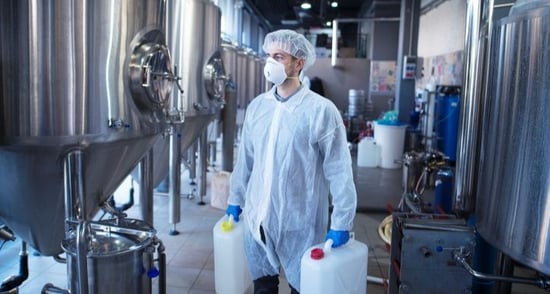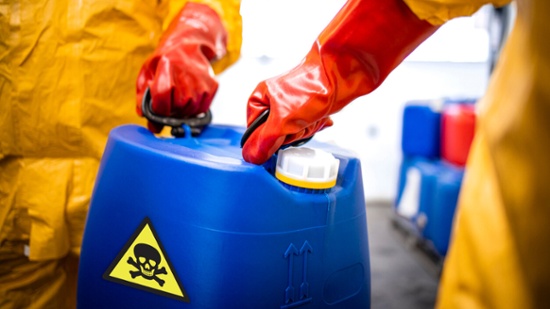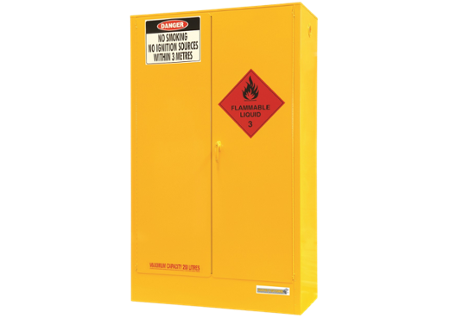Substances that create a risk to the health and safety of humans, other organisms and the environment are recognised as ‘hazardous chemicals’. These substances require careful management in the workplace, as they possess both physical hazards (eg, flammable, corrosive, chemically-reactive) and chemical hazards (eg, toxic, carcinogenic).
This post identifies the common chemical health hazards that could affect your staff. We also highlight how the toxicology of the hazardous chemical in your workplace may combine with other factors to create an immediate health affect. These chemical side effects could range from nausea, vomiting, chemical burns or poisoning, to a long-term disease or ailment, like dermatitis, lung damage or even cancer.
IMPORTANT: Hazardous chemicals are not just liquids; they may also be solids or gases and when used in the workplace could contaminate workers via fumes, vapours, dusts, smoke and mists.
Exposure to Hazardous Chemicals
There are countless hazardous chemicals in the home and the workplace, all with specific hazards to human health.
Harmful substances, such as pesticides, glues, disinfectants and caustic chemicals, can cause damage to humans (as well as other living creatures) through the routes of exposure.
So, how do hazardous substances enter the body?
In the next section, we’ll detail the routes of exposure and how these substances can cause harm.

Hazardous chemicals can affect human health through the routes of exposure.
Routes of Exposure
Without the correct personal protective equipment (PPE), ventilation and general working conditions, hazardous chemicals can harm the people in your organisation.
Hazardous chemicals can enter the body of your workers in a three ways:
1. Direct Contact With The Eyes Or Skin
One of the most obvious ways hazardous chemicals enter the body is by direct contact to the eyes or skin. Very often the reaction is quick and painful: the skin becomes red, swollen, blistered, or itchy while the eyes can immediately be rendered blind.
2. Inhaling (Breathing In) Hazardous Chemicals
Workers can inhale compressed gases, toxic smoke and mist, or the vapours and fumes from flammable liquids and poisons. Once inhaled, the chemicals move into the bloodstream. They can penetrate major organs like the lungs, liver and kidneys. Inhalation can also affect the reproductive and nervous systems of those exposed to hazardous chemicals.
3. Ingesting (Swallowing) Hazardous Substances
Many workers have died or suffered terrible injuries from ingesting or swallowing hazardous chemicals. Though it may seem unlikely an adult would knowingly swallow hazardous chemicals, it can happen accidentally. Toxic and corrosive chemicals placed in unsuitable containers, like cups or empty soft drink bottles without proper labels, have caused many workplace deaths and serious injuries.
Hazardous substances can also be ingested if a worker touches their mouth after handling chemicals and hasn’t washed their hands.
In one terrible accident, a worker swallowed carbolic acid after a burst pipe drenched him and the chemical and the acid was forced into his open mouth. Spilled chemicals can also settle on food, cigarettes, drinks or beards.
Adverse Health Effects of Hazardous Chemicals
When workers are exposed to hazardous chemicals, they can suffer immediate health effects (acute) or develop long term (chronic) health conditions.
Workers can develop both acute and chronic health conditions. For example, if a staff member is regularly using corrosive detergents and cleaners, they may suffer from inflamed skin and a rash (acute), but after years of direct skin contact, they may develop skin cancer (chronic).

Exposure to hazardous chemicals can result in acute and/or chronic health issues.
Acute Health Effects
An acute health effect is something that happens almost immediately and is usually visibly obvious. Burned skin, vomiting, coughing, itching, rashes, bleeding, dizziness, blindness, unconsciousness, and blistering are all acute conditions.
Chronic Health Effects
Sometimes when workers are exposed to chemicals the health effects are not immediately obvious: it may take weeks, months or years to develop an illness or disease. Asthma, dermatitis, liver damage and cancer are all diseases or conditions that can develop when workers are exposed to certain chemicals on a long-term basis.
REMEMBER: The Safety Data Sheet (SDS) for all hazardous chemicals show the health effects and first aid measures for all entry points eg, skin contact, eyes, inhalation, and swallowing.
Determining the Severity of a Chemical Hazard
The severity of a chemical hazard is not immediately obvious because it depends on more than the toxicity of the chemical. Accidents, injuries and illnesses from exposure to hazardous chemicals will depend on a combination of factors.
Some of these factors may include:
- The toxicity of the hazardous chemical eg, cyanide vs methylated spirits.
- Other reactive chemicals and conditions present eg, aerosol spray paint + heat.
- How the chemical enters the body eg, spilling a bit of toluene solvent on your skin vs inhaling the vapours.
- The dose (or amount of chemical) eg, falling into a vat of acid vs having acid splashed onto your hand.
- The length of exposure time eg, using spray paints for 1 hour per week vs spray painting 5 hours per day for 3 years.
- Individual health factors eg, metabolism, body size, age, smoker/non-smoker.
IMPORTANT: Relatively harmless chemicals are often overlooked in risk assessments. Don’t forget that continuous exposure to low toxicity chemicals can still be hazardous over a long period time.
Steps To Hazardous Chemical Safety
Because chemical health hazards are so complex, they require a full risk management approach to provide a safe working environment for workers.
There are several steps you can take in your own workplace to minimise the likelihood of harm occurring to your staff through hazardous chemical exposure.
We recommend taking a full risk management approach to your hazard chemicals by implementing the following assessments and safety precautions:

Risk Identification and Assessment
The first step in controlling hazards associated with chemicals in the workplace, is to clearly identify the substances and assess the hazards and level of risk.
Using a risk management methodology, you can systematically work through the process by identifying, assessing and controlling the risks of hazardous chemicals. You must then sustain compliance by undertaking regular inspections and reviews to ensure the controls have remained effective in an ever-changing workplace.
Chemical Storage & Handling Equipment
To control hazardous chemicals, we recommend implementing known control measures that meet the strict requirements of the Australian Standards.
These requirements shape how chemical storage and handling equipment is designed, constructed, used and maintained to better protect not only the people, but the property and environment of your workplace.
The requirements of the relevant Australian Standard/s that can be applied to chemical handling and storage in your operations to minimise exposure to harmful substances.
Storage, such as Class 3 Flammable Liquids Cabinets, can reduce both physical and health hazards.
Some solutions may include using flammable liquid cabinets, gas bottle cages, lubrication dispensers, spill bunds, and/or decanting stations in your operations. Make sure that the chemical storage that you select is specifically made for the hazard class of your substances.
Compliant storage assists with controlling both the physical and health hazards associated with harmful substances, so that staff can operate in a safer environment.
Chemical Storage & Hazard Controls
Exposure to hazardous chemicals is minimised through:
- Effective leak and spill containment
- Vapour controls or ventilation
- Dedicated storage away from incompatible substances
- Clearly placarded stores to inform staff of hazards
- Stores that are located within reach of emergency equipment
PPE and Emergency Equipment
An integral part of the risk management process with hazardous chemicals is the provision of the correct personal protective equipment (PPE).
Your safety data sheets will inform you of the appropriate personal protective equipment to minimise the likelihood of exposure to the substance. It must also be well maintained, properly cleaned and decontaminated, and fit-for-purpose. Make sure your staff know how to properly put on and take off the personal protective equipment, without risking chemical exposure.

PPE and emergency decontamination equipment are essential when working with harmful chemicals.
In addition to the provision (and maintenance) of PPE, you may also be required to install emergency decontamination equipment in your workplace.
Refer to the Australian Standards for your chemical class to determine if you need to install emergency showers, eyewash stations or both.
REMEMBER: PPE should be suitable for the chemical that you’re working with. There is no point in using personal protective equipment for flammable liquids if your staff are dealing with corrosive chemicals that require different hazard controls, ie. breathing apparatus.
Learning First Aid and Safety Protocol
Understanding how to respond to chemical exposure is key to ensuring their safety. Make sure that all staff are trained in first aid procedures and understand the appropriate safety protocols.
Whether it’s creating procedures for first aid for inhaling chemicals or treating a chemical burn, your workplace must develop procedures and implement training to inform staff of the ways to limit chemical exposure in the event of an accident.
Training should also be given in chemical safety, to ensure that all staff are aware of the hazards associated with each substance and how they should be safely handled and stored to limit exposure.
Utilising Independent Consultants to Control Hazards
Your team may not have sufficient experience or expertise to successfully create a safe working environment. However, there are professionals who can help you develop handling and storage solutions to protect the health and wellbeing of your staff.
We suggest obtaining the advice of professional safety consultants with field experience in your industry who can assess the hazards and risks accurately. Dangerous goods consultants may be able to assist with advice on chemical exposure levels and workplace exposure standards. They will also be able to conduct full workplace audits to identify other chemical safety risks that may be present.
Working with Harmful Chemicals
As we’ve highlighted in this post, there are three routes of exposure that may affect the health and wellbeing of staff who work in an environment with hazardous chemicals. The first step to reducing the risks associated with these substances is to clearly identify the hazards of your chemical products, and implement a range of controls, such as compliant storage and the correct PPE, to increase site safety.
To learn more about chemical safety management and applying a risk management methodology to the chemical hazards at your workplace, download our free eBook How to manage the risk of Hazardous Chemicals in the workplace. Our guide offers practical advice on chemical risk controls that you can easily apply to your own business. Get your copy for free today.
Joining the team as a Dangerous Goods Storage Consultant, Melissa Hampton became Storemasta's Marketing Manager in late 2021. With extensive knowledge and experience in chemical compliance, Melissa is responsible for leading the Marketing team and helping shape their marketing strategy. In her spare time, you can find Melissa hiking, swimming and enjoying the great outdoors in beautiful north-west Tasmania.

